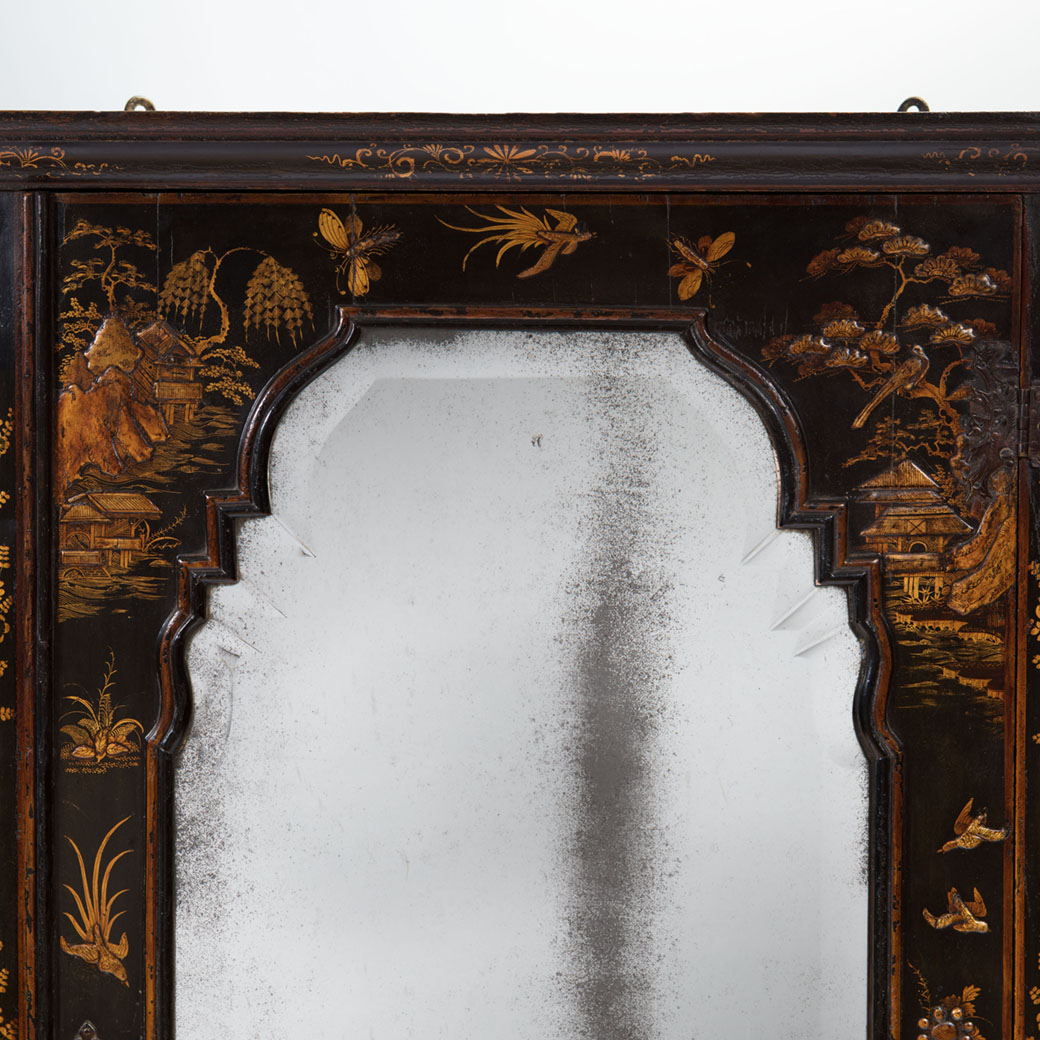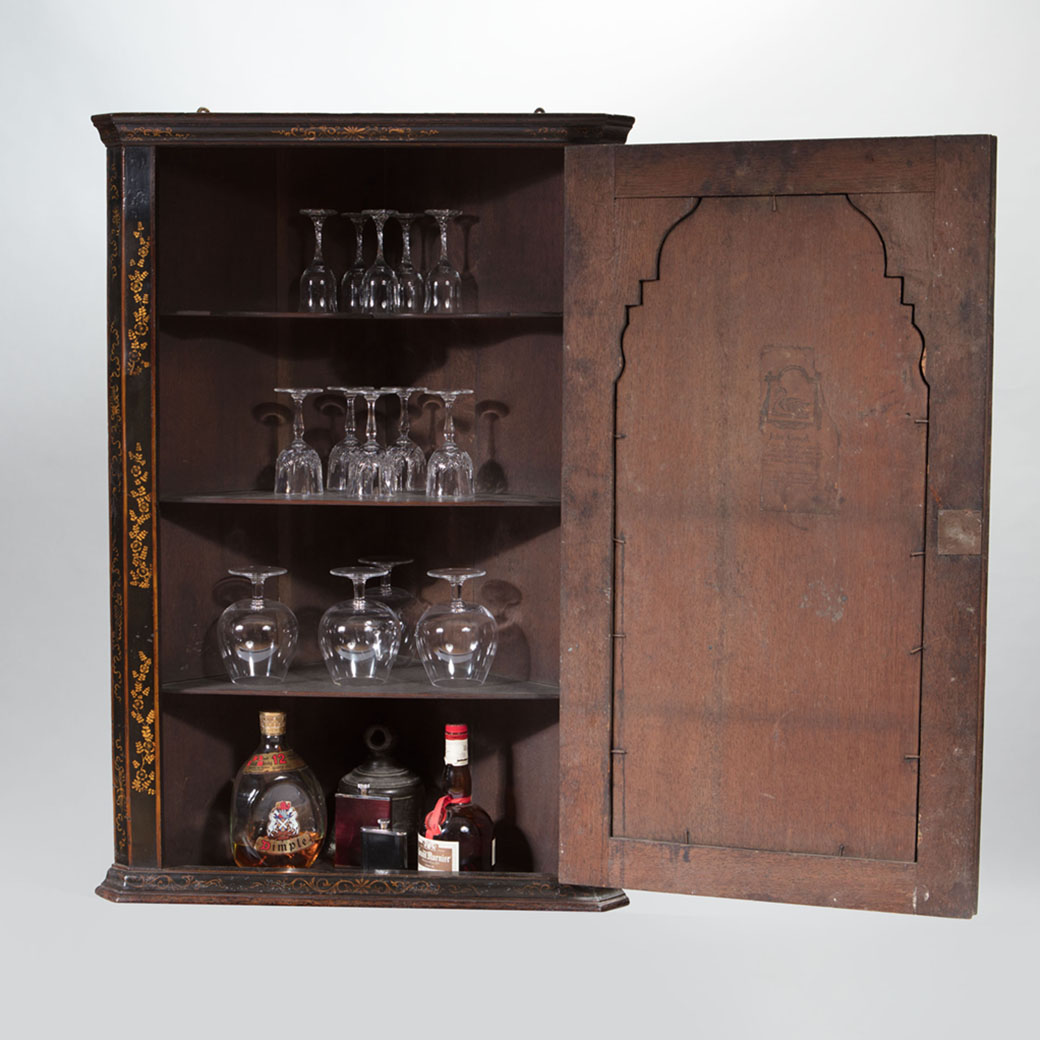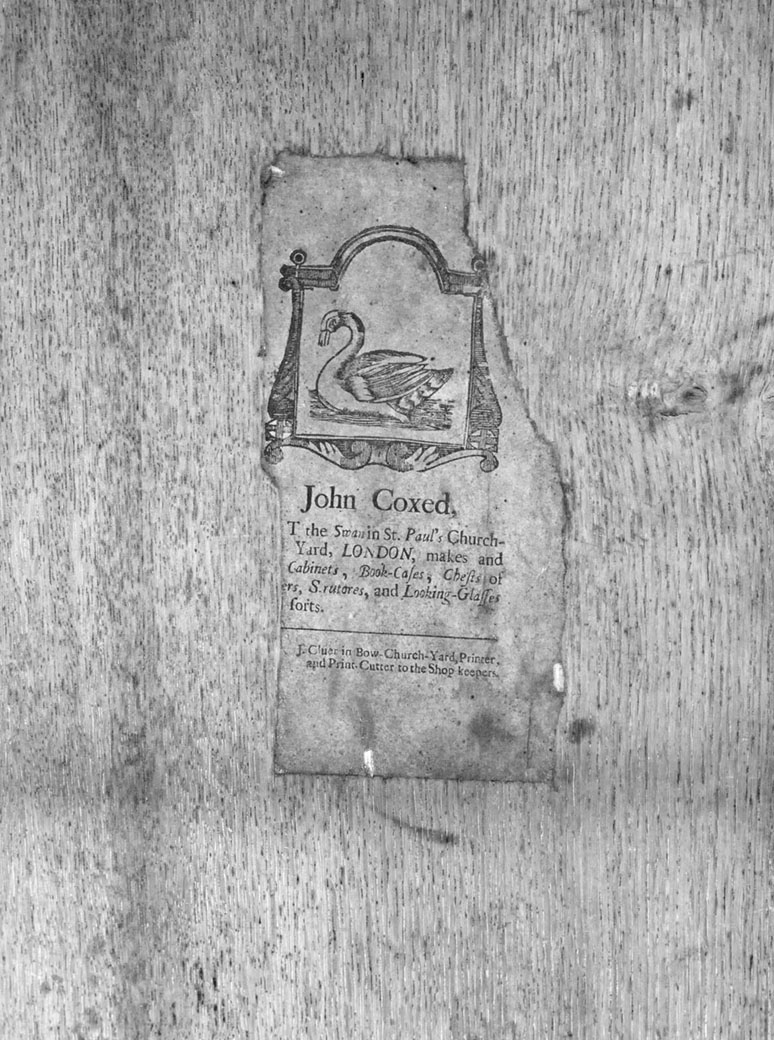JOHN COXED Also known as COXED & WOSTER (worked c.1700-c.1718)
Important Queen Anne Japanned Chinoiserie Corner Cupboard by John Coxed
1711-1715 England
Sold
Request Information
Follow Us
Important Queen Anne Japanned Chinoiserie Corner Cupboard by John Coxed
JOHN COXED Also known as COXED & WOSTER (worked c.1700-c.1718)
1711-1715 England
Important Queen Anne Japanned Chinoiserie Corner Cupboard by John Coxedard
The original bevelled mercury mirror plate is boarded by a double-d moulding and framed by its case of japanned, and detailed chinoiserie designs of differing forms. The chinoiserie work is incredibly fine for the period and includes figural scenes, a cliff face with lapping water, vegetation, insects, and birds to its entirety. The chased escutcheon is original along with the key, lock and opens to an interior of straight and shaped shelves of oak. Directly behind the mirror plate sits the original backboard with the earliest form of John Coxed trade label. The label reads “John Coxed T the Swan in St Pauls Church-Yard London, makes and cabinets, book-cases, chest of drawers, scrutoires, looking glasses, forts.” J. Clue in Bow Church-Yard Printer, and Print-Cutter to the shop keepers.
Six pieces of furniture bearing John Coxed’s labels have so far come to light, and they bear two different styles of label to which this is thought to be the earliest version. This corner cabinet is not only one, of the only now three known examples of the earliest form, but also the only recorded Japanned and chinoiserie piece by John Coxed (1711-1718). It is assumed that this label dates from 1711-1715 and the later version’ from 1715-18. This allows us the rare opportunity to accurately date this unique piece, to sometime between 1711-15.
Typically, Pieces by the outfit are veneered in walnut, mulberry or burr elm and stained to resemble tortoiseshell. Some pieces are embellished with kingwood cross-banding and pewter stringing. This metal line inlay was almost certainly due to the influence of Gerrit Jensen, who introduced such fashionable Continental habits into England in the late 17th century.
All known pieces by Coxed and Woster are in important private collections and museums, to include, The V&A Museum, Colonial Williamsburg, Rousham House and Alexander George Fine Antiques Ltd.
John Belchier also operated from the Southside of St Pauls Churchyard, just a few doors down from Coxed in the first quarter of the 18th century. The earliest reference to John Belchier can be found in the accounts of Boughton House between 1687 and 1710. Belchier is most famous for his Chinoiserie work and it is possibly or even highly likely that it was he who undertook the chinoiserie work of the corner cabinet we are offering.
Condition
Original condition
Dimensions
Height 38.00 inch (96.52 cm)
Width 26.00 inch (66.04 cm)
Depth 14.50 inch (36.83 cm)
Provenance
Private London collection
Literature
The trade label from this corner cupboard is illustrated in the ‘Pictorial Dictionary Of Marked London Furniture, 1700- 1840’, page 153, fig 236, by leading furniture historian Christopher Gilbert.
Dictionary Of English Furniture Makers 1660-1840, by The Furniture History Society, page 205.
PREVIOUSLY SOLD

17th Century Charles II Carved Oak Writing Box or Desk Box circa 1660 England
17th Century Charles II Carved Oak Writing Box or Desk Box SoldFollow Us17th Century Charles II Carved Oak Writing Box or Desk Box A rare 17th-century Charles II carved oak writing or desk box, circa 1660. England. The box opens on the...

Pair of George IV Regency Specimen Wood Parquetry Boxes of Sarcophagus Shape
Pair of George IV Regency Specimen Wood Parquetry Boxes of Sarcophagus Shape SoldFollow UsPair of George IV Regency Specimen Wood Parquetry Boxes of Sarcophagus Shape An extremely rare and fine pair of George IV Regency exotic timber boxes of...
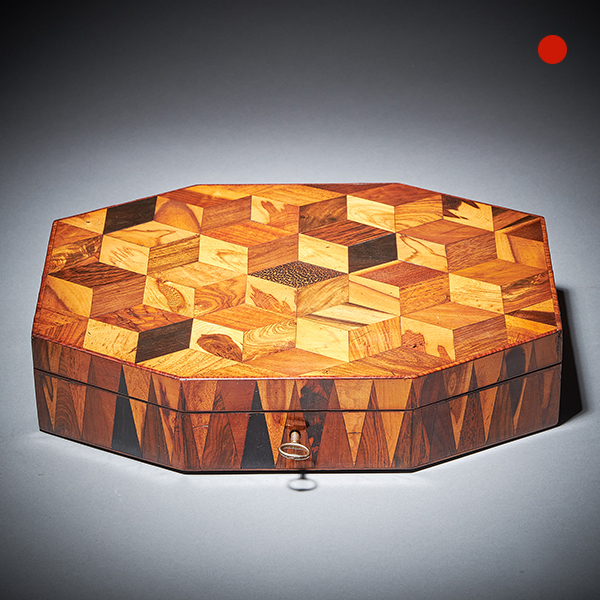
George IV Regency Exotic Wood Specimen Parquetry Games Box or Jewellery Box
George IV Regency Exotic Wood Specimen Parquetry Games or Jewellery Box SoldFollow UsGeorge IV Regency Exotic Wood Specimen Parquetry Games or Jewellery Box An extremely rare and fine example, decorated to all surfaces with exotic timbers....

18th Century George II Mahogany Caddy-Topped Chest by Giles Grendey C.1730-1740
18th Century George II Mahogany Caddy-Topped Chest by Giles Grendey, C.1730-1740 Sold Follow Us18th Century George II Mahogany Caddy-Topped Chest by Giles Grendey, C.1730-1740 An important George II mahogany caddy-topped chest, circa...
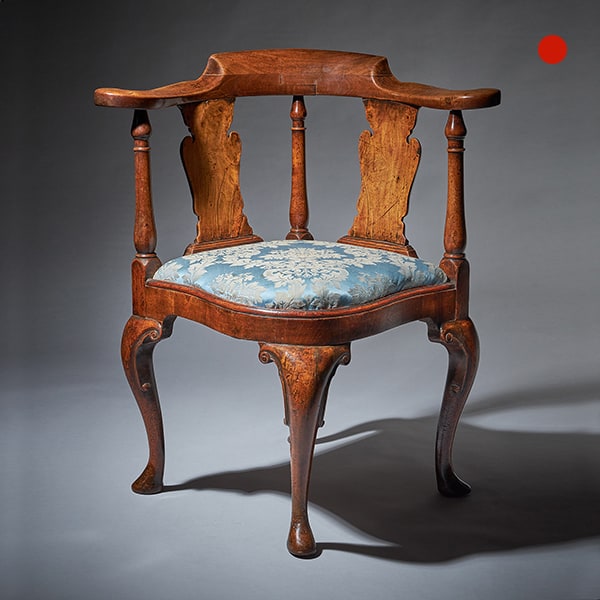
Queen Anne Period Walnut Corner Chair Circa 1702-1714
Queen Anne Period Walnut Corner Chair, Circa 1702-1714 Sold Follow UsQueen Anne Period Walnut Corner Chair, Circa 1702-1714 Queen Anne period walnut corner chair, 1702-1714. It is solid walnut, raised on four boldly carved cabriole legs with...
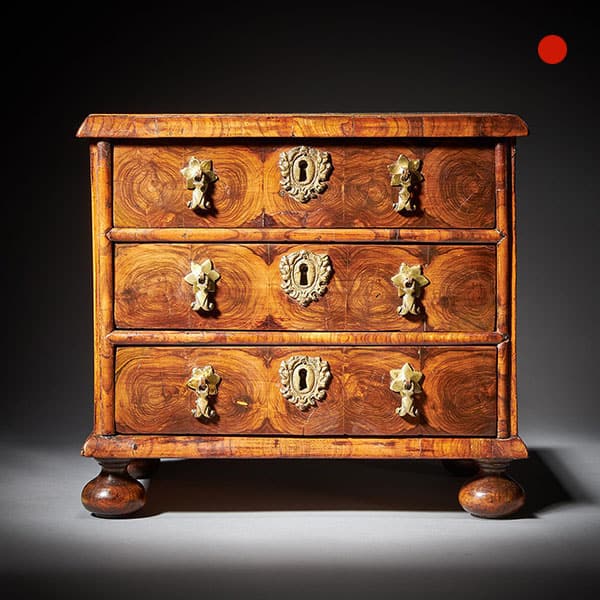
Miniature William and Mary Diminutive Olive Oyster Chest C.1688-1702
Miniature William and Mary Diminutive Olive Oyster Chest, C.1688-1702 Sold Follow UsMiniature William and Mary Diminutive Olive Oyster Chest, C.1688-1702 From the reign of King William & Queen Mary (1688-1702), England. The finely...

17th Century Charles II Carved Oak Writing Box or Desk Box circa 1660 England
17th Century Charles II Carved Oak Writing Box or Desk Box SoldFollow Us17th Century Charles II Carved Oak Writing Box or Desk Box A rare 17th-century Charles II carved oak writing or desk box, circa 1660. England. The box opens on the...

Pair of George IV Regency Specimen Wood Parquetry Boxes of Sarcophagus Shape
Pair of George IV Regency Specimen Wood Parquetry Boxes of Sarcophagus Shape SoldFollow UsPair of George IV Regency Specimen Wood Parquetry Boxes of Sarcophagus Shape An extremely rare and fine pair of George IV Regency exotic timber boxes of...

George IV Regency Exotic Wood Specimen Parquetry Games Box or Jewellery Box
George IV Regency Exotic Wood Specimen Parquetry Games or Jewellery Box SoldFollow UsGeorge IV Regency Exotic Wood Specimen Parquetry Games or Jewellery Box An extremely rare and fine example, decorated to all surfaces with exotic timbers....

18th Century George II Mahogany Caddy-Topped Chest by Giles Grendey C.1730-1740
18th Century George II Mahogany Caddy-Topped Chest by Giles Grendey, C.1730-1740 Sold Follow Us18th Century George II Mahogany Caddy-Topped Chest by Giles Grendey, C.1730-1740 An important George II mahogany caddy-topped chest, circa...

Queen Anne Period Walnut Corner Chair Circa 1702-1714
Queen Anne Period Walnut Corner Chair, Circa 1702-1714 Sold Follow UsQueen Anne Period Walnut Corner Chair, Circa 1702-1714 Queen Anne period walnut corner chair, 1702-1714. It is solid walnut, raised on four boldly carved cabriole legs with...

Miniature William and Mary Diminutive Olive Oyster Chest C.1688-1702
Miniature William and Mary Diminutive Olive Oyster Chest, C.1688-1702 Sold Follow UsMiniature William and Mary Diminutive Olive Oyster Chest, C.1688-1702 From the reign of King William & Queen Mary (1688-1702), England. The finely...
YOU MAY ALSO LIKE

A George II Irish Mahogany Secretaire Kneehole Bookcase Att. C. Hearn
A George II Irish Mahogany Secretaire Kneehole Bookcase Att. C. Hearn £45,900Follow UsA George II Irish Mahogany Secretaire Kneehole Bookcase Att. C. Hearn An original and rare two-part George II 18th century Irish architects figured mahogany...

17th Century Lantern Alarm Clock by Johannes Quelch, Oxford
17th Century Lantern Alarm Clock by Johannes Quelch, Oxford £14,000Follow Us17th Century Lantern Alarm Clock by Johannes Quelch, Oxford An English 17th century lantern clock made of brass and iron, circa 1665-1670. The clock consists of going...

19th-Century Flame Mahogany Mantel Clock by BREGUET Raised by Lion Paw Feet
19th-Century Flame Mahogany Mantel Clock by BREGUET Raised by Lion Paw Feet £23,500Follow Us19th-Century Flame Mahogany Mantel Clock by BREGUET Raised by Lion Paw Feet EXTREMELY RARE MANTEL CLOCK WITH A FIGURED MAHOGANY-VENEERED CASE by A-L...

Unusual Ribbed Eight-Day Repeating Striking Gilt-Brass Gorge Case Carriage Clock
Unusual Ribbed Eight-Day Repeating Striking Gilt-Brass Gorge Case Carriage Clock £4,850Follow UsUnusual Ribbed Eight-Day Repeating Striking Gilt-Brass Gorge Case Carriage Clock CaseThe clock has a gilt-brass case which is a variation on the...

Fine 18th Century George I Gilt Gesso Pier or Console Mirror, Manner of Belchier
Fine 18th Century George I Gilt Gesso Pier or Console Mirror, Manner of Belchier £13,900Follow UsFine 18th Century George I Gilt Gesso Pier or Console Mirror, Manner of Belchier A fine and rare early 18th century George I Gilt Gesso pier or...

17th Century William and Mary Olive Oyster Lace Box, Circa 1680-1700
17th Century William and Mary Olive Oyster Lace Box, Circa 1680-1700 £3,900Follow Us17th Century William and Mary Olive Oyster Lace Box, Circa 1680-1700 A fine and rare 17th-century William and Mary period olive oyster lace box of perfect...

A George II Irish Mahogany Secretaire Kneehole Bookcase Att. C. Hearn
A George II Irish Mahogany Secretaire Kneehole Bookcase Att. C. Hearn £45,900Follow UsA George II Irish Mahogany Secretaire Kneehole Bookcase Att. C. Hearn An original and rare two-part George II 18th century Irish architects figured mahogany...

17th Century Lantern Alarm Clock by Johannes Quelch, Oxford
17th Century Lantern Alarm Clock by Johannes Quelch, Oxford £14,000Follow Us17th Century Lantern Alarm Clock by Johannes Quelch, Oxford An English 17th century lantern clock made of brass and iron, circa 1665-1670. The clock consists of going...

19th-Century Flame Mahogany Mantel Clock by BREGUET Raised by Lion Paw Feet
19th-Century Flame Mahogany Mantel Clock by BREGUET Raised by Lion Paw Feet £23,500Follow Us19th-Century Flame Mahogany Mantel Clock by BREGUET Raised by Lion Paw Feet EXTREMELY RARE MANTEL CLOCK WITH A FIGURED MAHOGANY-VENEERED CASE by A-L...

Unusual Ribbed Eight-Day Repeating Striking Gilt-Brass Gorge Case Carriage Clock
Unusual Ribbed Eight-Day Repeating Striking Gilt-Brass Gorge Case Carriage Clock £4,850Follow UsUnusual Ribbed Eight-Day Repeating Striking Gilt-Brass Gorge Case Carriage Clock CaseThe clock has a gilt-brass case which is a variation on the...

Fine 18th Century George I Gilt Gesso Pier or Console Mirror, Manner of Belchier
Fine 18th Century George I Gilt Gesso Pier or Console Mirror, Manner of Belchier £13,900Follow UsFine 18th Century George I Gilt Gesso Pier or Console Mirror, Manner of Belchier A fine and rare early 18th century George I Gilt Gesso pier or...

17th Century William and Mary Olive Oyster Lace Box, Circa 1680-1700
17th Century William and Mary Olive Oyster Lace Box, Circa 1680-1700 £3,900Follow Us17th Century William and Mary Olive Oyster Lace Box, Circa 1680-1700 A fine and rare 17th-century William and Mary period olive oyster lace box of perfect...




